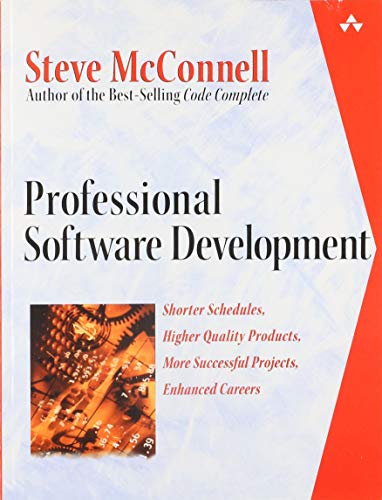Professional Software Development: Shorter Schedules, Higher Quality Products, More Successful Projects, Enhanced Careers - Softcover

Synopsis
Renowned software expert Steve McConnell helps software students transition to the role of software professionals. Significant developments are afoot that will impact the future careers of student programmers, including initiatives in education, professional development, certification, and licensing. Some of these developments are well thought out and positive; others are being forced and need to be improved before they are standardized. Software development is changing, whether programmers recognize it or not. Programmers who are not paying attention could easily find themselves working as twenty-first century software janitors. This book describes the occupation of computer programming as it exists today and the profession of software engineering as it can exist in the future.
"synopsis" may belong to another edition of this title.
From the Back Cover
Can you deliver 90% of your software on time, within budget, and fully meet the user's real requirements? Would you like to? Best-selling author Steve McConnell provides a compelling argument for turning software success into an everyday habit by advancing the software profession itself―at the individual, organizational, and industry levels. Expanding on the contents of his previous book After the Gold Rush, the author dispels common myths of software development.
If you are a programmer, software developer, engineer, or work in software development, you should READ THIS BOOK.
Why do so many companies use outdated and ineffective software development practices? See page 103
What is "cargo cult" software development, and who uses it? See page 23
How large is the return on investment for better software practices? Can you prove it? See page 115
How do you create career paths for software professionals? See page 143
Which affects projects more--good personnel or good process? See page 135
How much difference is there between the worst software companies and the best? See page xv
0321193679B06052003
"About this title" may belong to another edition of this title.
Search results for Professional Software Development: Shorter Schedules,...
Professional Software Development: Shorter Schedules, Higher Quality Products, More Successful Projects, Enhanced Careers
Seller: Your Online Bookstore, Houston, TX, U.S.A.
paperback. Condition: Good. Seller Inventory # 0321193679-3-35317403
Professional Software Development: Shorter Schedules, Higher Quality Products, More Successful Projects, Enhanced Careers
Seller: Orion Tech, Kingwood, TX, U.S.A.
paperback. Condition: Good. Seller Inventory # 0321193679-3-35246585
Professional Software Development: Shorter Schedules, Higher Quality Products, More Successful Projects, Enhanced Careers
Seller: Bookmonger.Ltd, HILLSIDE, NJ, U.S.A.
paperback. Condition: Very Good. Crease on cover*. Seller Inventory # mon0000705745
Professional Software Development : Shorter Schedules, Higher Quality Products, More Successful Projects, Enhanced Careers
Seller: Better World Books: West, Reno, NV, U.S.A.
Condition: Good. 1st. Used book that is in clean, average condition without any missing pages. Seller Inventory # 6102364-6
Professional Software Development: Shorter Schedules, Higher Quality Products, More Successful Projects, Enhanced Careers
Seller: ThriftBooks-Atlanta, AUSTELL, GA, U.S.A.
Paperback. Condition: Very Good. No Jacket. May have limited writing in cover pages. Pages are unmarked. ~ ThriftBooks: Read More, Spend Less. Seller Inventory # G0321193679I4N00
Professional Software Development: Shorter Schedules, Higher Quality Products, More Successful Projects, Enhanced Careers
Seller: ThriftBooks-Dallas, Dallas, TX, U.S.A.
Paperback. Condition: Fair. No Jacket. Readable copy. Pages may have considerable notes/highlighting. ~ ThriftBooks: Read More, Spend Less. Seller Inventory # G0321193679I5N00
Professional Software Development: Shorter Schedules, Higher Quality Products, More Successful Projects, Enhanced Careers
Seller: HPB-Red, Dallas, TX, U.S.A.
paperback. Condition: Good. Connecting readers with great books since 1972! Used textbooks may not include companion materials such as access codes, etc. May have some wear or writing/highlighting. We ship orders daily and Customer Service is our top priority! Seller Inventory # S_412374310
Professional Software Development: Shorter Schedules, Higher Quality Products, More Successful Projects, Enhanced Careers
Seller: HPB-Red, Dallas, TX, U.S.A.
paperback. Condition: Very Good. Connecting readers with great books since 1972! Used textbooks may not include companion materials such as access codes, etc. May have some wear or limited writing/highlighting. We ship orders daily and Customer Service is our top priority! Seller Inventory # S_425096056
Professional Software Development: Shorter Schedules, Higher Quality Products, More Successful Projects, Better Software Careers
Seller: AwesomeBooks, Wallingford, United Kingdom
Paperback. Condition: Very Good. Professional Software Development: Shorter Schedules, Higher Quality Products, More Successful Projects, Better Software Careers This book is in very good condition and will be shipped within 24 hours of ordering. The cover may have some limited signs of wear but the pages are clean, intact and the spine remains undamaged. This book has clearly been well maintained and looked after thus far. Money back guarantee if you are not satisfied. See all our books here, order more than 1 book and get discounted shipping. Seller Inventory # 7719-9780321193674
Buy Used
Quantity: 2 available
Professional Software Development: Shorter Schedules, Higher Quality Products, More Successful Projects, Enhanced Careers
Seller: ebooks Keystone, Reading, PA, U.S.A.
Condition: good. This book is in good condition, with minimal signs of wear and tear. Seller Inventory # GWKV.0321193679.G
